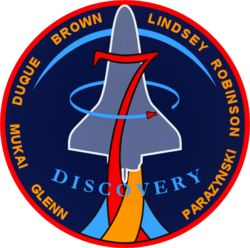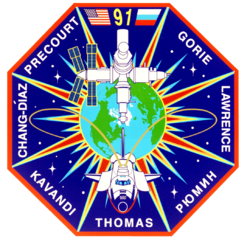STS-91
| STS-91 | |||||
 | |||||
| Uppdrag | ? | ||||
|---|---|---|---|---|---|
| Rymdfärja | Discovery (24)[1] | ||||
| NSSDC-ID | 1998-034A[2] | ||||
| Färdens tid | 9 dagar, 19 timmar, 55 minuter, 1 sekunder | ||||
| Uppskjutning | |||||
| Startplats | Startplatta 39A vid Kennedy Space Center i Florida | ||||
| Start | 2 juni 1998 6:06:24 p.m. EDT | ||||
| Landning | |||||
| Landningsplats | KSC | ||||
| Landning | 12 juni 1998 2:00:17 p.m. EDT | ||||
| Omloppsbana | |||||
| Varv | 154 st[3] | ||||
| Apogeum | 328 km | ||||
| Perigeum | 239 km | ||||
| Banlutning | 51,6° | ||||
| Dockning | |||||
| Rymdstation | Mir | ||||
| Dockning | 4 juni 1998, 16:58 UTC | ||||
| Urdockning | 8 juni 1998, 16:01 UTC | ||||
| Tid dockad | 3 dagar, 23 timmar, 3 minuter | ||||
| Besättning | |||||
| Befälhavare | Charles J. Precourt (4) | ||||
| Pilot | Dominic L. Pudwill Gorie (1) | ||||
| Uppdragsspecialister | Wendy B. Lawrence (3) Franklin R. Chang-Diaz (6) Janet L. Kavandi (1) Valery Victorovitch Ryumin (4) Ryssland | ||||
 | |||||
| Kronologi Rymdfärjeprogrammet | |||||
| |||||
STS-91 var en flygning i det amerikanska rymdfärjeprogrammet. Flygningen genomfördes med rymdfärjan Discovery. Den sköts upp från Pad 39B vid Kennedy Space Center i Florida den 2 juni 1998. Efter nästan tio dagar i omloppsbana runt jorden återinträdde rymdfärjan i jordens atmosfär och landade vid Kennedy Space Center.
Det var den sista flygningen med en rymdfärja till den ryska rymdstationen Mir.
Flygningens mål var att leverera utrustning och förnödenheter till rymdstationen, detta gjorde man med hjälp av en Spacehab-modul placerad i rymdfärjans lastrum.
Se även
Referenser
- ^ NASA Space Shuttle Launch Archive Arkiverad 4 mars 2016 hämtat från the Wayback Machine., läst 28 juli 2016.
- ^ ”NASA Space Science Data Coordinated Archive” (på engelska). NASA. https://nssdc.gsfc.nasa.gov/nmc/spacecraft/display.action?id=1998-034A. Läst 22 mars 2020.
- ^ Manned Astronautics - Figures & Facts Arkiverad 26 september 2015 hämtat från the Wayback Machine., läst 28 juli 2016.
Externa länkar
 Wikimedia Commons har media som rör STS-91.
Wikimedia Commons har media som rör STS-91.
| ||||||||
| |||||||||||||
| ||||||||||||||||||||||||||||||||
Media som används på denna webbplats
MIR Space Station Emblem
The STS-95 patch, designed by the crew, is intended to reflect the scientific, engineering, and historic elements of the mission. The Space Shuttle Discovery is shown rising over the sunlit Earth limb, representing the global benefits of the mission science and the solar science objectives of the Spartan Satellite. The bold number '7' signifies the seven members of Discovery's crew and also represents a historical link to the original seven Mercury astronauts. The STS-95 crew member John Glenn's first orbital flight is represnted by the Friendship 7 capsule. The rocket plumes symbolize the three major fields of science represented by the mission payloads: microgravity material science, medical research for humans on Earth and in space, and astronomy.
STS-91 CREW INSIGNIA (March 1998) --- This is the crew patch for the STS-91 mission -- the ninth flight of the Shuttle-Mir Phase One docking missions. The crew will bring back Andrew S. W. Thomas, the last long-duration American crew member flown on the Russian Space Station Mir. This mission marks the end of the Shuttle-Mir Phase One Program and will open the way for Phase Two: construction of the International Space Station (ISS). The crew patch depicts the rendezvous of the Space Shuttle Discovery with the Space Station Mir. The flags of the United States and Russia are displayed at the top of the patch and both countries are visible on the Earth behind the two spacecraft. The names of the American crew members surround the insignia on the outer areas, with the name of cosmonaut Valery Ryumin in Cyrillic at the lower right. The Alpha Magnetic Spectrometer (AMS) is an international payload planned to fly in the payload bay of Discovery. Two thin golden streams flowing into the AMS represent charged elementary particles. The detection of antimatter in space will help scientists better understand the physics and origins of the universe.
Författare/Upphovsman: Pascal (Flickr user: pasukaru76), Licens: CC0
Vostok spacecraft replica at the Technik Museum Speyer, Germany.
STS-90 insignia
- The STS-90 crew patch reflects the dedication of the mission to neuroscience in celebration of the decade of the brain. Earth is revealed through a neuron-shaped window, which symbolizes new perspectives in the understanding of nervous system development, structure and function, both here on Earth and in the microgravity environment of space.
- The Space Shuttle Columbia is depicted with its open payload bay doors revealing the Spacelab within. An integral component of the mission, the laboratory/science module provided by the European Space Agency (ESA), signifies the strong international involvement in the mission. The seven crew members and two alternate payload specialists, Chiaki Naito-Mukai and Alexander W. Dunlap, are represented by the nine major stars of the constellation Cetus (the whale) in recognition of the International Year of the Ocean.
- The distant stars illustrate the far reaching implications of the mission science to the many sponsoring agencies, helping prepare for long-duration space flight aboard the International Space Station (ISS).
- The moon and Mars are depicted to reflect the crew's recognition that those two celestial bodies will be the next great challenges in human exploration of space and represent the key role that life science research will play in supporting such missions.
STS-91 CREW PORTRAIT (January 1998) --- The final crew members scheduled to visit Russia's Mir Space Station pose for a crew portrait during training at the Johnson Space Center (JSC). Pictured with their helmets in front are astronauts Dominic C. Gorie (left) and Charles J. Precourt. Others, from the left, are Wendy B. Lawrence, Franklin R. Chang-Diaz, Janet L. Kavandi, Valeriy V. Ryumin and Andrew S. W. Thomas. Precourt is mission commander, and Gorie, pilot, for Discovery's summer 1998 mission to Mir. Thomas, who will have been serving as a guest researcher on Mir since late January, will return to Earth with the crew members. Lawrence, Chang-Diaz, Kavandi and Ryumin are all mission specialists. Ryumin represents the Russian Space Agency (RSA). Discovery will carry the single module version of Spacehab for the scheduled nine-day mission.









